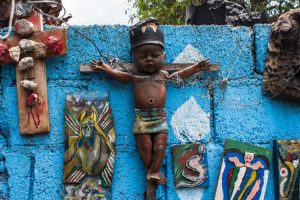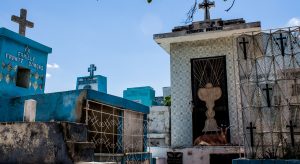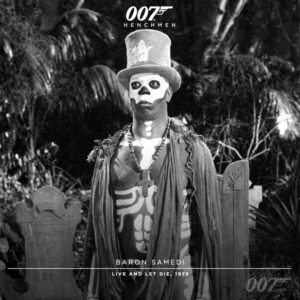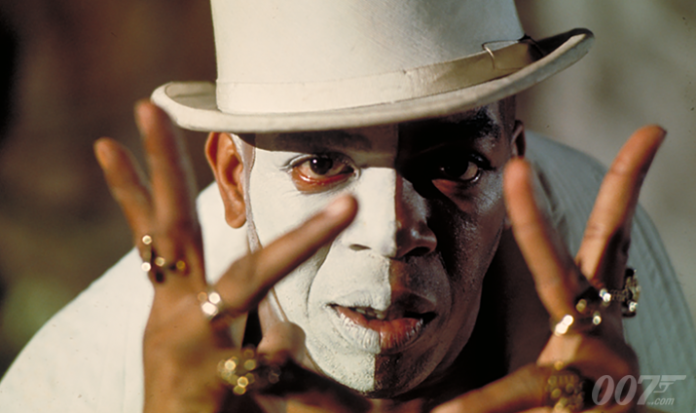(THIS ARTICLE IS MACHINE TRANSLATED by Google from Norwegian)
The amazing camera work in Good Vision however, did not result in membership in any photography association – such organizations tend to exclude four-legged members. Britis is a goat. In the film, the British cemetery visits and explores the Grand Cimetière in Port-au-Prince Haiti – a permanent home for many of his kind, as well as for numerous people, both living and dead.
Britis was equipped with harness and a GoPro camera and was thus able to perpetuate for posterity their travels through a cemetery which is sprinkled with grave supports. Geita's services were hired for a day's recording of an artist trio – Steevens Simeon from Haiti and two steady Brazilians, Jefferson Kielwagen and Marcos Serafim. This happened during the fifth Ghetto Biennale in Port-au-Prince – a sober counterpart to the large and relatively lavish Venice Biennale.
Baron Samedi is perhaps the most famous of all voodoo scenes.
The result of the footage was then edited down to a 15-minute movie called Good Vision, which was presented in 2018 at a variety of shows and festivals in the US, UK, Netherlands, Brazil, Israel, Serbia and Haiti. However, it seems like it went under the radar of the biggest and most prestigious festivals for documentary and experimental films. This is astonishing, given that Good Visions'originality, visual delight and captivating balance between extreme simplicity and underlying complexity are enough to secure a place in any serious list of 2018's most notable awards – no matter their length.
Voodoo references
A word about the title (which, like all other "dialogue" heard in the film, is Haitian-Creole): Vision- the part is self-explanatory; gede it's a little worse. But goat (also known as Guédé or Ghee) are the spirits responsible for death and fertility in Haitian water (that is to say voodoo), and their area logically includes burial sites such as the expansive hillside of Grand Cimetière. Goat dominates two of the film's three audio elements: as well as the sound from the GoPro camera (which includes Britis' accidental breaking and scratching with clover on the rock bottom). But we also hear incantations og poem performed by Jean-Daniel Lafontant, a the houngan (waterpriest) from the Nah-Ri-Veh Temple (which housed one of the biennial's opening ceremonies, which is said to have been an "epic night"). kind of "high priestess" in religion.

Lafontants and Thelus' vocal contributions weave a seductive network waterreferences to the prominent lwa - also known as loa, a concept of prayers directed to spirits. God Himself – known as Bondye, a word derived from French Good God – ensures interactions between people and lwa. Goats often show up in waterteachings and rituals; they are often used as sacrifices, and the meat is eaten at special parties.
“The goat was bought at a market in Port-au-Prince. Even though the cemetery is full of goats, we wanted to make sure we had at least secured one so that we could mount the GoPro camera and release it again, ”Serafim explains.
Britis was named after Jean-Simon Britis (also called Brutus), the cemetery's protective spirit. The latter's name is mentioned in the film along with more famous names like "the Baron" – that is, Baron Samedi, head of gede and a kind of lord over the dead. The Baron is perhaps the most famous of all water-vesener; he even emerges as a seemingly immortal villain in the James Bond success Live and Let Die from 1973. However Good Vision is obviously made up for a fraction of the 007 movie's budget. It is a typical inventive, low-budget expression of the Ghetto Biennial – established by artist collective Atis Rezistans and co-financed by Cheshire-born Leah Gordon and André Eugène, a native of Port-au-Prince.
Tour of the Grand Cimetière
Good Visions naked aesthetics and collective origin (Brazilian / Haitian, artist / religious, human / goat) are together an irresistible work that seeks cohesion and empathy with all residents of Cimetière – a necropolis with a population that increased significantly after the earthquake devastated much of the capital in January 2010. Most of the robust cemetery remained intact after the earthquake, and became a not very temporary home for dozens of homeless families. Understandably, given the macabre surroundings, the burial ground was also a bit of a fireplace superstition after a disaster that, by calculation, destroyed a quarter of a million homes. And this in what was already the poorest country in the Western Hemisphere.

Seven years later, then Good Vision was filmed, Haiti had barely recovered from the natural disaster; the cemetery was still (and is) a bit of a center for bustling activity. Britis turns out to be an excellent guide as it squeezes through narrow passages as the reviewer rushes from crypt to crypt: People give in to the goat, some understandably a little astonished by this camera-carrying creature.
Another goat rests in the sun, and somewhere our unnoticed protagonist stops to scratch some twigs. Later, the camera loosens, and the film gets a surreal upside-down feel; planes take off with white condensation strips in the blue December sky. Britis, who is a little bothered by the harness and would like to find a protected spot away from people who can imagine herding goat for dinner, finally shakes herself free and is barely visible in the closing seconds.
Goats often show up in vodou teachings and rituals; they are often used as victims, and
the meat is eaten at special parties.
At this stage we have had privileged access to what has been a confusing and informative "tour", with a captivating extra layer of spirituality provided by Lafontant and Thelus. The film begins in the media's journey, without introduction or explanation; the camera is unsteadily placed (handheld, presumably) around knee height, and then a lively inspection journey begins.
Apart from an early treacherous sound, it is only halfway into the film that even the most vigilant viewer discovers who – or what – it is like movies; in the last third, a hairy ear is clearly visible in the bottom right of the picture frame.
RIP British
Of course, this is not the first time a non-human "camera person" has helped make a movie – there was a lot of talk about an event in Cannes (of all places) in 2011, when an opportunistic gull went off with a GoPro and flew up to the city's most elevated castle – resulting in a rather astonishing 100-second "movie".

Men Good Vision combines this radical approach with sensitive immersion in a folkloric culture of faith. In a grandiose and extremely graceful way, it transcends what could become a clumsy conceptual gimmick, using 21st-century technology to create a vision of a labyrinthine environment – in a way completely timeless – like no awkward human ever could be obtained without the assistance of a goat.
The end, on the other hand, is sad. Jefferson Kielwagen writes: "[After the filming] we changed Britis to Papa-Da, waterpriest and one of the artists of the Atis Resistanz group, against a couple of his sculptures. Weeks later, we were told that Britis had been sacrificed in one waterritual and consumed by the people of Atis Resistanz. " RIP Britis… but thanks Good Vision he now has some sort of cinematic immortality, at least.


